Are you concerned that you may have cataracts? Cataracts are common in adults who are over the age of 40.
When you have cataracts, it can get progressively harder to see as they make your natural lens more cloudy over time. The only way to treat cataracts is to have cataract surgery.
This procedure removes the natural lens and replaces it with an artificial lens, known as an intraocular lens (IOL). Cataract surgery is a common procedure that’s been around for many years and has continued evolving since its development.
Keep reading to learn more about cataracts and what IOLs do during cataract surgery!
How Cataract Surgery Works

Cataract surgery is one of the most commonly performed medical procedures in the world. It’s an outpatient procedure, meaning the patient goes home the same day they have it.
It’s also a relatively quick surgery. It involves a cataract surgeon creating a small incision in the eye, breaking the natural lens into smaller pieces.
These smaller pieces are then removed through the incision, and the artificial lens replaces where the natural lens was. The surgeon makes sure the IOL is in place and aligned correctly during this time.
There’s no need for general anesthesia, with the patient instead receiving eye drops that numb the eye’s surface to prevent them from feeling any pain during the procedure.
Traditional cataract surgery uses a tiny bladed instrument to create the incision, while a device that emits ultrasound waves is used to break up the lens. Laser cataract surgery is performed in a very similar way to traditional cataract surgery, except it doesn’t use any blades.
Instead, it uses a laser to create both the incision and soften the natural lens. By using a laser, the lens breaks apart more easily.
Results from laser cataract surgery can be more precise, and you may recover more quickly. However, both kinds of cataract surgery accomplish the same thing: removing your eye’s natural lens and replacing it with an intraocular lens.
How IOLs Function
An IOL works the same way that your natural lens worked before it became cloudy and made it more difficult to see clearly because of cataracts. If you wear glasses or contacts, you probably know that they’re designed to correct how light refracts when it passes through your eye.
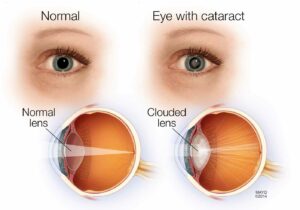
If you’re nearsighted or farsighted, your cornea doesn’t refract light correctly, so the lenses of your glasses or contacts bend it the right way before it passes through your eye. An IOL functions the same way, but instead of bending light before it passes through your eye, the IOL replaces the natural lens.
There are many kinds of IOLs, but patients usually choose between a monofocal intraocular lens and premium intraocular lenses. Monofocal IOLs are the standard IOL and only correct one focal point, meaning you’ll have to wear glasses if you want to see other distances beyond the one focal point the monofocal lens corrects.
If you choose a premium IOL, you can correct refractive errors like nearsightedness, farsightedness, and astigmatism during cataract surgery. The beauty of a premium intraocular lens is that it can provide you with some of the best vision you’ve ever had, even before you had cataracts!
Many patients with cataracts also have presbyopia, another common age-related condition that makes it hard to see up close. Some IOLs will also correct presbyopia, allowing you to reduce your dependence on reading glasses!
The Different Kinds of IOLs at New England Eye Center
Although cataract surgery is technically an elective procedure, it is something that most health insurance plans will cover. Cataract surgery is necessary because it preserves a patient’s vision.
If you choose a monofocal lens, this is even covered by Medicare. Other intraocular lenses are not, however. Before cataract surgery, you’ll select an intraocular lens based on what your ophthalmologist recommends, as well as your lifestyle and visual needs after cataract surgery. At New England Eye Center, we offer a variety of intraocular lenses to our patients with cataracts, including:
Alcon PanOptix Trifocal Lens

The PanOptix trifocal IOL is the first and only trifocal lens to become FDA approved. With this intraocular lens, patients can see clearly at all distances, including up-close, intermediate distances, and far away.
Patients with this IOL have clearer and sharper sight and rely less on glasses, meaning they can finally experience visual freedom! The PanOptix intraocular lens also provides patients with excellent intermediate vision, which is especially important if you spend a lot of time in front of a computer or using your phone to text your loved ones.
It’s also available in a toric model for those with astigmatism.
Tecnis Symfony Lens
The Symfony intraocular lens provides patients with a continuous range of full vision, meaning they can see without boundaries at all distances. The Symfony IOL is another premium lens that allows patients to decrease their dependence on glasses after having cataract surgery.
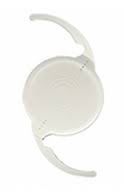
This means that if you have presbyopia and cataracts and are tired of reading glasses, the Symfony IOL may be able to reduce your dependency on them after cataract surgery! For patients with astigmatism, the Symfony lens is also available in a toric model.
Alcon ReSTOR

Another IOL offered to patients looking for clearer vision at near, intermediate, and a distance is the ReSTOR intraocular lens. This IOL helps reduce dependence on glasses after cataract surgery.
Crystalens
The Crystalens is an accommodative IOL that improves nearsightedness and intermediate vision for cataract patients. The lens accommodates, meaning it’s modeled to move like the human eye.
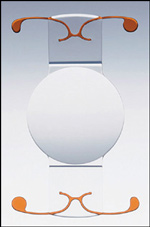
The accommodation helps your eyes adapt to distances more efficiently and without struggling to focus. Patients end up with brighter and clearer vision along with no longer having cataracts.
Tecnis Lens
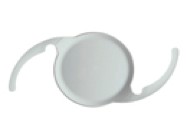
The Tecnis intraocular lens is a multifocal lens that improves the quality of vision, no matter what distance you may need to see. With the Tecnis IOL, you’ll be able to see well in all lighting conditions and see more clearly after cataract surgery.
TRULIGN Toric
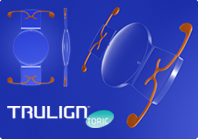
The TRULIGN toric lens is one of several toric lenses available at the New England Eye Center. Toric lenses are for people with astigmatism, which occurs when the cornea is in an irregular shape.
When it’s this shape, it leads to visual aberrations, including refractive errors like nearsightedness and farsightedness. A toric lens corrects astigmatism and other refractive errors during cataract surgery.
Choosing an IOL is an essential part of preparing to have cataract surgery. Your eye doctor will make a recommendation for you after discussing your goals, visual needs, and how you see yourself after having cataract surgery.
Wondering which IOL may be right for you? Schedule your cataract consultation at New England Eye Center in Boston, MA, today!
Don’t let cataracts stop you from being who you want to be any longer!
